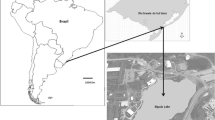Abstract
The objectives of this research were to record the changes in composition of the open-water, bottom-dwelling chironomid fauna in Lake Balaton between 1978–1984, to examine the causes of these changes, and to discover their significance in the life of the lake.
The spatio-temporal dispersion of larvae is compared with the water and sediment quality of each basin in the lake. It is established that, under present conditions, nutrient status can be regarded as the chief environmental factor.
Studies of population dynamics show that chironomids play a highly important role in preserving sediment quality. Chironomids are an essential element in the organic matter circulation of the lake. They dominate a sub-system that retards water quality degradation, and thus they play a prominent role in the natural prevention of eutrophication.
Similar content being viewed by others
References
Brundin, L., 1958. The bottom faunistical lake type system and its application to the southern hemisphere. Moreover a theory of glacial erosion as a factor of productivity in lakes and oceans. Verh. int. Ver. Limnol. 13: 288–297.
Carter, C. E., 1976. A population study of the Chironomidae (Diptera) of Lough Neagh. Oikos 27: 346–354.
Carter, C. E., 1977. The recent history of the chironomid fauna of Lough Neagh, from the analysis of remains in sediment cores. Freshwat. Biol. 7: 415–423.
Carter, C. E., 1978. The fauna of the muddy sediments of Lough Neagh, with particular reference to eutrophication. Freshwat. Biol. 8: 547–559.
Cole, R. A. & D. L. Weigmann, 1983. Relationships among zoobenthos, sediments, and organic matter in littoral zones of western Lake Erie and Saginaw Bay. J. Great Lakes Res. 9: 568–581.
Dévai, Gy., 1980. Vorstudien zur Bedeutung der sedimentbewohnenden Zuckmücken im Stoflhaushalt des Balatonsees (Ungarn). In D. A. Murray (ed.), Chironomidae. Proc. 7th int. Symp. on Chironomidae, Dublin, August, 1979. Pergamon Press, Oxford: 269–273.
Dévai, Gy., 1981. [A review of sediment studies on Lake Balaton. In I. Kárpáti (ed.), New Results of Balaton research II.] MTA VEAB Monográfiái 16: 201–209 (in Hungarian with English summary).
Dévai, Gy., (ed.), 1984. Studies of the ecological effects of Lake Balaton and River Zala sediments on chironomids (Diptera: Chironomidae). Acta biol. debr. oecol. hung. 1: 1–183, Tab. 1–7, Fig. 1–59.
Dévai, Gy., 1988. Emergence patterns of chironomids in Keszthely-basin of Lake Balaton (Hungary). Spixiana, Suppl. 14: 201–211.
Dévai, Gy., I. Czégény, I. Dévai & F. Máté, (1980) 1982. [Relationship between bottom-dwelling chironomid fauna and the sediment quality of Lake Balaton. Part one. Iron and manganese content of the sediment]. Acta biol. debr. 17: 51–74 (in Hungarian).
Dévai, Gy., & J. Moldován, 1983. An attempt to trace eutrophication in a shallow lake (Balaton, Hungary) using chironomids. Hydrobiologia 103: 169–175.
Dévai, Gy., W. Wülker & A. Scholl, 1983. Revision der Gattung Chironomus Meigen (Diptera). IX. C. balatonicus sp.n. aus dem Flachsee Balaton (Ungarn). Acta zool. hung. 29: 357–374.
Entz, B., 1964. Ernährungs-Untersuchungen an Chironomiden des Balaton. I. Quantitative Ernährungs-Untersuchungen an Larven von Chironomus plumosus L. Annal. biol. Tihany 31: 165–175.
Heim, Cs., I. Dévai & J. Harangi, 1984. Gas chromatographic method for the determination of elemental sulphur in sediments. J. Chromatogr. 295: 259–263.
Kajak, Z., 1980. Role of invertebrate predators (mainly Procladius sp.) in benthos. In D. A. Murray (ed.), Chironomidae. Proc. 7th int. Symp. on Chironomidae, Dublin, August, 1979. Pergamon Press, Oxford: 339–348.
Kansanen, P. H. & J. Aho, 1981. Changes in the macrozoobenthos associations of polluted Lake Vanajavesi, Southern Finland, over a period of 50 years. Ann. zool. fenn. 18: 73–101.
Saether, O. A., 1975. Nearctic chironomids as indicators of lake typology. Verh. int. Ver. Limnol. 19: 3127–3133.
Saether, O. A., 1979. Chironomid communities as water quality indicators. Holarct. Ecol. 2: 65–74.
Saether, O. A., 1980. The influence of eutrophication on deep lake benthic invertebrate communities. Prog. Wat. Tech. 12: 161–180.
Somlyódy, L., S. Herodek & J. Fischer (eds.), 1983. Eutrophication of shallow lakes: modeling and management. The Lake Balaton case study. Collaborative Proc. Ser. CP-83-S3. IIASA, Laxenburg, x + 369 pp.
Stahl, J. B., 1966. Characteristics of a North American Sergentia lake. Gewäss. Abwäss. 41–42: 95–122.
Stahl, J. B., 1969. The uses of chironomids and other midges in interpreting lake histories. Mitt. int. Ver. Limnol. 17: 111–125.
Thienemann, A., 1954. Chironomus. Leben, Verbreitung und wirtschaftliche Bedeutung der Chironomidan. In A. Thienemann (ed.), Die Binnengewässer 20. E. Schweizerbart'sche Verlagsbuchhandlung, Stuttgart, XVI + 834 pp.
Tóth, J. A., Zs. Preczner & S. Nagy, 1986. [Relationship between redoxpotential, organic carbon content and the number of bacteria in the sediment of shallow waters]. Hidr. Közl. 66: 102–107 (in Hungarian with English summary).
Warwick, W. F., 1975. The impact of man on the Bay of Quinte, Lake Ontario, as shown by the subfossil chironomid succession (Chironomidae, Diptera). Verh. int. Ver. Limnol. 19: 3134–3141.
Wiederholm, T. & L. Eriksson, 1979. Subfossil chironomids as evidence of eutrophication in Ekoln Bay, Central Sweden. Hydrobiologia 62: 195–208.
Author information
Authors and Affiliations
Rights and permissions
About this article
Cite this article
Dévai, G. Ecological background and importance of the change of chironomid fauna (Diptera: Chironomidae) in shallow Lake Balaton. Hydrobiologia 191, 189–198 (1990). https://doi.org/10.1007/BF00026052
Issue Date:
DOI: https://doi.org/10.1007/BF00026052




